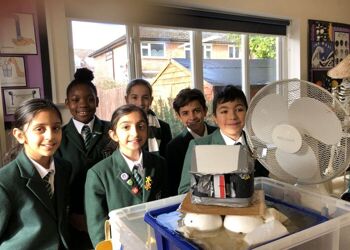Year 5 STEM Ambassadors
Posted on: 20/01/2023At St. Helen’s College we are always working to ensure that our curriculum is balanced, dynamic, forward-looking and, most of all, memorable and engaging. We guide the children to learn in many different ways and enjoy setting tasks that develop skills across the curriculum so that they may hone knowledge and skills in several subjects at once. STEM (Science, Technology, Engineering and Maths) is a huge area and one on which we focus in order to prepare our children in the best way for the ever-evolving world ahead of them. We are also careful to embed themes of Climate Change and Sustainability throughout the children’s learning so that they can work to make sure that our world survives for future generations.
We are proud that our pupils learn to work independently from a young age and, while we have a large staff of enthusiastic, specialist teachers who love nothing more than to be involved with the children, we guard against over-reliance on adults in the classroom. One of the ways in which we encourage both independence and teamwork is through requiring children to work collaboratively so that, through discussion and thoughtful teacher facilitation, they may direct their own learning.
Recently, guided by Ms Gilham, our Year 5 children have been working on a project that embodies these philosophies. Ms Gilham explains:
The Year 5 children were set a challenge (from stem.org) to build a flood-proof house on Watu Island. They were required to design their house, build it and pitch their house to the rest of the group at the end of the project.
Their ‘hook’ was a picture of social injustice as one of the many impacts of climate change: a family stuck on a corrugated iron roof with rising flood waters around them. Rising sea levels mean that families from developing countries suffer greatly, losing homes and livelihoods, an injustice caused by CO2 emissions (largely from other parts of the world) which bring about global warming.
In teams, the Year 5 children reflected on this in order to understand the need for building cost-effective, sustainable and flood proof houses. They followed this process as the project went on:
-
Design And Build - together, we looked at typical houses and how to adapt these into structures that could float. The children undertook a survey of Watu Island, taking into account amenities and location and likelihood of flooding. This brought into play their art and geography skills and enhanced their decision making on matters of practicality.
-
Testing And Evaluation Of Materials - we considered the suitability of various materials, thinking about their properties including strength and how water proof and flood proof they might be. This required scientific evaluation, prediction and investigation.
-
Costing The Build - each material was assigned a different cost and the children had a budget to which they had to stick. In order to ‘purchase’ the materials they required to build their house, they needed to practise their maths and learn to make smart decisions on the sustainability of materials, also taking into account the manufacture and transport of those materials.
-
Reflection On Values Learned - the children thought about their outcomes, including their own contribution to their team’s work and the determination, creativity, decision making and problem solving they had practised and developed.
The project experience highlighted the strengths of each team member and of each team as a collective. Weaknesses were also identified and, through collaboration and problem solving skills, were addressed. This process helped the children to develop skills and knowledge across the STEM subjects.
Testing the children’s completed houses in simulated flood conditions was so much fun! The children watched anxiously to see how their own houses would fare and were encouraging to other teams as their houses attempted to survive flood and cyclone conditions. They then considered why one house turned out to be more flood-proof than another.

The Winning Team!
Here are some examples of the pupils’ learning shown through their reflections, opinions, thoughts and the presentations in which they pitched their houses to their peers. At the end of the process, the children evaluated each presentation, rated the houses based on the four main points and voted for the best house.
As a practitioner and as Science Subject Leader, I am always working to develop the science curriculum in a fun and practical-based way as well as to make it challenging for the children. I believe that we achieved these aims in this project. In reviewing the children’s pictures, videos, written work and in conversations with them, it was clear to see that they were engaged and excited learners, that they developed several skills and acquired a lot of important knowledge and that they were able to reflect on their learning in order to use it as a springboard for the future. Like the pupils and like the other teachers here, I too constantly reflect on what happens in the classroom and use what I have learnt to refine and improve my practice.
Thank you, Ms Gilham, for guiding the children through such a well-planned, well-executed, interesting and important project.
For me as Head, what is perhaps most exciting is that this Year 5 project is just a snapshot of the enormous variety of learning opportunities offered to children throughout the school each day. St. Helen’s College is a place filled daily with those ‘lightbulb moments’ where children discover something new about the world and themselves. It is a pleasure and a privilege for the staff here to guide your children’s learning. Do keep asking them each day what they have done, what they have learnt and what they are looking forward to next. Your engagement with their learning will make a huge difference too.
Ms Drummond




